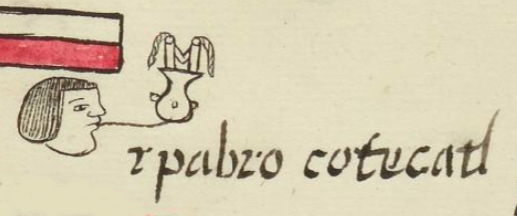Contecatl (MH744v)
This black-line drawing of the compound glyph for the personal name, title, or ethnicity, Contecatl (perhaps “Person of Contlan”), is attested here as pertaining to an elite man. One of the elements in the compound is a ceramic pot or jug (comitl) with a flared neck and at least three handles. The jug provides phonetic the start (Co- or Con-) to the name. Above that is an object typically used as a glyph for Tecpanecatl (see below). It has a shape something like the letter capital M, but each vertical segment has a small circle on the top. Marc Thouvenot (personal communication 30 September 2024) suggests that this sign refers to a cuauhtecpantli, a phonetic indicator for the Tecpan- start to that title. Coming off from the circles at the top of the fence posts are short, twisted ropes (perhaps mecatl, a phonetic complement for the -ecatl ending to the title).
Stephanie Wood
The word conteca appears in the Florentine Codex as a form of the verb teca, to lay out, with a directional (-on-) and an object (c-). (See our entry for teca in the Online Nahuatl Dictionary.) But such a reading seems unlikely here, where names that end in -teca are often referring to an affiliation with a pueblo—likely intending Contlan here. Since the term in the Florentine Codex does not end with -tecatl but rather -teca, it is plural, referring to the people of Contlan. But this glyph is a singular noun.
Stephanie Wood
1560
Jeff Haskett-Wood
cerámica, jarras, etnicidad, pueblos, afiliación, nombres de hombres, ollas

teca, to lay out, https://nahuatl.wired-humanities.org/content/teca
com(itl), ceramic pot, https://nahuatl.wired-humanities.org/content/comitl
-teca (affiliation suffix), https://nahuatl.wired-humanities.org/content/teca-0
una persona de Contlan
Stephanie Wood
Matrícula de Huexotzinco, folio 744v, World Digital Library, https://www.loc.gov/resource/gdcwdl.wdl_15282/?sp=567&st=image
This manuscript is hosted by the Library of Congress and the World Digital Library; used here with the Creative Commons, “Attribution-NonCommercial-ShareAlike 3.0 License” (CC-BY-NC-SAq 3.0).










